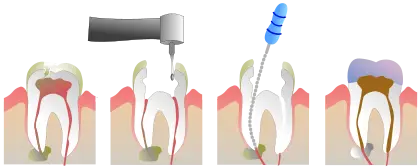Root canal treatment is often perceived as one of the most daunting dental treatments because of the fear of pain associated with it. In this blog post, we have shared some of the facts related to pain management for your root canal treatment that you must know.
Understanding the Fear of Pain
The fear of pain in dental procedures, particularly root canals, is a common concern among patients. This fear can stem from past experiences, horror stories from others, or simply the anxiety associated with dental treatments.
It is crucial for dental professionals to acknowledge this fear and work towards minimizing pain to ensure a smoother experience for patients.
Preoperative Evaluation
Before diving into the technical aspects of pain management, it’s essential to begin with a thorough preoperative evaluation. Dentists must take into consideration the patient’s medical history, allergies, and current medications because they may affect the choice of anesthesia and pain management techniques.
Local Anesthesia: The Foundation of Pain Management
Local anesthesia is the cornerstone of pain management in a root canal therapy. It is administered to ensure that the patient does not feel any pain during the treatment.
- Local Anesthetic Choice: Dentists typically use local anesthetics such as lidocaine or articaine. The selection may depend on factors like the patient’s medical history, allergies, and the specific tooth being treated.
- Techniques for Anesthesia: Dentists use various techniques for administering local anesthesia. The common ones include infiltration, nerve blocks, and intraligamental injections. Nerve blocks like the Gow-Gates technique or the Akinosi block are especially useful for mandibular molars.
- Topical Anesthesia: To further reduce discomfort during injection, topical anesthesia is applied to the injection site. This helps numb the surface tissues, making the needle insertion less painful.
- Slow Injection: Administering the local anesthetic slowly can significantly reduce the pain associated with a rapid injection.
- Buffered Anesthetics: Buffering the anesthetic solution with sodium bicarbonate can reduce the burning sensation upon injection.
Managing Anxiety and Discomfort
Apart from physical pain, patient anxiety and discomfort can also affect the overall experience. Dental professionals employ several strategies to mitigate these issues:
- Distraction Techniques: Engaging the patient in conversation or providing headphones with soothing music can help divert their attention from the procedure.
- Nitrous Oxide Sedation: For anxious patients, nitrous oxide sedation is an option that reduces both pain perception and anxiety.
The Role of Rubber Dam Isolation
Rubber dam isolation is a crucial step in root canal procedures. It not only ensures a clean and sterile field but also prevents contact with irritants, reducing patient discomfort. When the tooth is isolated, there is less chance of debris or irrigants coming into contact with other oral tissues.
Effective Pulpal Debridement
Pulpal debridement is an essential step in root canal procedures, especially for patients experiencing pain. Removing necrotic tissue and irritants from the pulp chamber can alleviate pressure and provide immediate relief. This step also contributes to the overall success of the treatment.
Utilizing Anesthetic Techniques During Treatment
During the root canal procedure itself, various anesthetic techniques and strategies are employed to minimize pain:
- Cooling Irrigation: Using room-temperature or cooled irrigation solutions helps prevent thermal sensitivity and minimizes patient discomfort.
- Efficient Instrumentation: Dentists aim for efficient cleaning and shaping of the canals. Modern rotary instruments are often used as they reduce the risk of file separation and procedural pain.
Intracanal Medication for Pain Management
In some cases, especially those with significant infection or inflammation, dentists may use intracanal medication. Calcium hydroxide, for example, is applied to reduce inflammation and pain. This medicament also helps in disinfection and promotes healing.
Post-Operative Pain Management
Pain management doesn’t end with the completion of the root canal procedure. Dentists need to provide patients with guidance on how to manage pain and discomfort in the post-operative period:
- Prescription of Analgesics: Dentists often prescribe pain-relief medications like ibuprofen or acetaminophen. It’s essential to provide clear instructions regarding their use.
- Post-Op Ice Packs: Recommending the application of ice packs to the outside of the cheek for the first 24 hours can help reduce swelling and pain.
- Follow-Up Appointment: Scheduling a follow-up appointment allows the dentist to assess the healing process and address any persistent pain or discomfort promptly.

